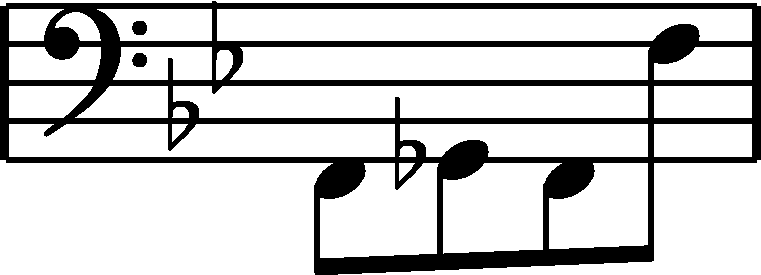



Issues : Accompaniment changes
|
b. 161
|
composition: Op. 2, Variations, complete
..
The version of AsI, written here for the first time (see b. 135-139), undoubtedly presents the initial edition of the alternative accompaniment, generally based on three-note chords, as in the repetition of this phrase an octave higher (b. 165 and the analogous previous ones). Particularly on the 2nd quaver, there was initially an e category imprint: Graphic ambiguousness; Differences between sources; Corrections & alterations; Source & stylistic information issues: Accompaniment changes |
|||||||||
|
b. 162
|
composition: Op. 2, Variations, complete
..
The correction entered into AsI on the 2nd quaver in the previous bar, which allows to avoid a situation in which c1 is played simultaneously by both hands, makes us think that Chopin wanted to change accordingly the 2nd quaver in the discussed bar too already back then; however, he implemented it only just in A. category imprint: Differences between sources; Corrections & alterations issues: Accompaniment changes |
|||||||||
|
b. 174
|
composition: Op. 2, Variations, complete
..
In the main text we stand by the undoubtedly later version of A (→GE→FE,EE,FESB). Rhythmically speaking, it is also closer to the orchestral version, in which we can hear 4 quavers in the cellos and basses: category imprint: Differences between sources; Corrections & alterations issues: Accompaniment changes |
|||||||||
|
b. 175
|
composition: Op. 2, Variations, complete
..
The version of AsI fairly corresponds to the orchestral version, in which the 2nd and 3rd quavers are almost (in AsI) or completely (in the printed voices) identical, as far as the pitch is concerned. It was also in A (→GE→EE,FESB) that Chopin only complemented the R.H. chords. The proofreading of FE – undoubtedly Chopinesque – brought about a major change, and this is the version (the latest one) we give in the main text. An alternative proposal, analogous to the endings of Variation I and Variation III, takes into account a possible misunderstanding in implementing the proofreading corrections. category imprint: Differences between sources; Corrections & alterations issues: Accompaniment changes , Authentic corrections of FE , Main-line changes |
|||||||||
|
b. 176
|
composition: Op. 2, Variations, complete
..
In AsI the 2nd half of the bar most probably had 3 versions, out of which we give the earliest, written down in regular script, as the text of this manuscript (it is compliant with the version of the remaining sources). According to us, the text added then in a smaller, draft-like script contains a version used in the remaining sources in b. 180 and 192 and its earlier edition, written down as if they created one version. The existence of two editions of this melodic and rhythmic idea is indicated by the different size of noteheads and by the record, suggesting replacing smaller notes with slightly bigger ones (yet still smaller than in the initial record). category imprint: Graphic ambiguousness; Differences between sources; Corrections & alterations; Source & stylistic information issues: Chopin's hesitations , Accompaniment changes , Main-line changes |

 -g-c1 three-note chord, in which Chopin removed c1, since it was present in the R.H. figuration, but probably added a c, which we give as the text of this source.
-g-c1 three-note chord, in which Chopin removed c1, since it was present in the R.H. figuration, but probably added a c, which we give as the text of this source.  .
.
